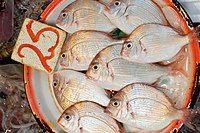Processing
Fish is a highly perishable product: the "fishy" smell of dead fish is due to the breakdown of amino acids into biogenic amines and ammonia.[48]
Live food fish are often transported in tanks at high expense for an international market that prefers its seafood killed immediately before it is cooked. Delivery of live fish without water is also being explored.[49] While some seafood restaurants keep live fish in aquaria for display purposes or cultural beliefs, the majority of live fish are kept for dining customers. The live food fish trade in Hong Kong, for example, is estimated to have driven imports of live food fish to more than 15,000 tonnes in 2000. Worldwide sales that year were estimated at US$400 million, according to the World Resources Institute.[50]
If the cool chain has not been adhered to correctly, food products generally decay and become harmful before the validity date printed on the package. As the potential harm for a consumer when eating rotten fish is much larger than for example with dairy products, the U.S. Food and Drug Administration (FDA) has introduced regulation in the USA requiring the use of a time temperature indicator on certain fresh chilled seafood products.[51]
Because fresh fish is highly perishable, it must be eaten promptly or discarded; it can be kept for only a short time. In many countries, fresh fish are filleted and displayed for sale on a bed of crushed ice or refrigerated. Fresh fish is most commonly found near bodies of water, but the advent of refrigerated train and truck transportation has made fresh fish more widely available inland.[52]
Long term preservation of fish is accomplished in a variety of ways. The oldest and still most widely used techniques are drying and salting. Desiccation (complete drying) is commonly used to preserve fish such as cod. Partial drying and salting are popular for the preservation of fish like herring and mackerel. Fish such as salmon, tuna, and herring are cooked and canned. Most fish are filleted before canning, but some small fish (e.g. sardines) are only decapitated and gutted before canning.[53]
Consumption
This section needs additional citations for verification. (July 2021) |
Seafood is consumed all over the world; it provides the world's prime source of high-quality protein: 14–16% of the animal protein consumed worldwide; over one billion people rely on seafood as their primary source of animal protein.[54][55] Fish is among the most common food allergens.
Since 1960, annual global seafood consumption has more than doubled to over 20 kg per capita. Among the top consumers are Korea (78.5 kg per head), Norway (66.6 kg) and Portugal (61.5 kg).[56]
The UK Food Standards Agency recommends that at least two portions of seafood should be consumed each week, one of which should be oil-rich. There are over 100 different types of seafood available around the coast of the UK.
Oil-rich fish such as mackerel or herring are rich in long chain Omega-3 oils. These oils are found in every cell of the human body, and are required for human biological functions such as brain functionality.
Whitefish such as haddock and cod are very low in fat and calories which, combined with oily fish rich in Omega-3 such as mackerel, sardines, fresh tuna, salmon and trout, can help to protect against coronary heart disease, as well as helping to develop strong bones and teeth.
Shellfish are particularly rich in zinc, which is essential for healthy skin and muscles as well as fertility. Casanova reputedly ate 50 oysters a day.[57][58]
Texture and taste
Over 33,000 species of fish and many more marine invertebrate species have been identified.[59] Bromophenols, which are produced by marine algae, give marine animals an odor and taste that is absent from freshwater fish and invertebrates. Also, a chemical substance called dimethylsulfoniopropionate (DMSP) that is found in red and green algae is transferred into animals in the marine food chain. When broken down, dimethyl sulfide (DMS) is produced, and is often released during food preparation when fresh fish and shellfish are heated. In small quantities it creates a specific smell one associates with the ocean, but in larger quantities gives the impression of rotten seaweed and old fish.[60] Another molecule known as TMAO occurs in fishes and gives them a distinct smell. It also exists in freshwater species, but becomes more numerous in the cells of an animal the deeper it lives, so fish from the deeper parts of the ocean have a stronger taste than species that live in shallow water.[61] Eggs from seaweed contain sex pheromones called dictyopterenes, which are meant to attract the sperm. These pheromones are also found in edible seaweeds, which contributes to their aroma.[62]
Health benefits
You received this message because you are subscribed to the Google Groups "1top-oldtattoo-1" group.
To unsubscribe from this group and stop receiving emails from it, send an email to 1top-oldtattoo-1+unsubscribe@googlegroups.com.
To view this discussion on the web visit https://groups.google.com/d/msgid/1top-oldtattoo-1/CAGNPKmm54HG2p%2B9GbYrkWBWiXGyOnKd7smywVDxyuy8p6QABMg%40mail.gmail.com.









No comments:
Post a Comment